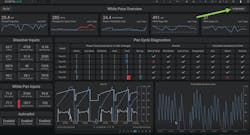To help users find insights faster with available software tools, Kelly Kolotka, analytics engineer at Seeq, reports it recently developed several generative artificial intelligence (gen AI) assistants for its industrial analytics software by using large-language model (LLM) software in the Chat Generative Pre-Trained Transformer (GPT) chatbot. These tools include:
- Data Lab Agent to generate code, help debug programs, and review and assist users with Python code development;
- Formula Agent that lets users employ plain language to develop formulas;
- General Agent that shows users just starting with AI tools how to clean signals, find periods of interest, and complete other basic tasks; and
- Actions Agent that accepts written prompts for different tasks, and performs the tasks to complete them.
Get your subscription to Control's tri-weekly newsletter.
“This isn’t about replacing engineers. It’s about helping them do their jobs better,” says Kolotka. “However, some process facilities, such as refineries, may have a siloed culture for engaging in new analytics or bringing in new controls. Consequently, Seeq focuses on keeping the subject matter experts (SME) at the center, so their cross-functional collaboration is streamlined when trying to perform a root-causes analyses, determine why anomalies are happening, or develop a simple interface that’s easy for their team to access, adopt and share.”
For instance, Andres Barbaro, engineering VP at Seeq, reports its AI Assistant is infused with process and analytics capabilities, informed by time-series and SME context in Seeq’s collaborative platform, drives traceable and profitable results two to eight times faster than before, and delivers scalable solutions.
“This goes beyond simply answering questions to where the ecosystem begins to be in play because AI Assistant needs to understand what and why you’re asking something. So, with an initial question, a tremendous amount of knowledge and context can supplement the prompt to enrich the eventual answer,” says Barbaro, who spoke at Seeq’s Conneqt 2024 conference in May in Miami. “We have lots of people working to understand the questions relevant in an analytics platform and their standard intent. There are some questions to reject or are outside the context of the analytics an AI Assistant can do. We’re trying to build a system that will always give you a plan, and be transparent about what it’s thinking and doing. Users can always stop it and tell it, ‘You didn’t get me to the right spot—let’s go a different way.’ We did a lot of work to teach an analytics framework way beyond the models.”
Consequently, Seeq Workbench can be directed by AI Assistant to search for and add data items, such as a signal named “Temperature-Area C,” from a specific data source, identify outlier sensor readings, and execute an analysis that removes spikes to create a new, clean temperature signal with the outliers removed. “We’re excited to put our analytics platform together with AI Assistant because a regular generative AI model couldn’t clean the signal in this way,” adds Barbaro. “It’s really Seeq Formula doing the hard work. We can also use AI Assistant to close gaps in the graph where the outliers were removed. We can then create a condition when the absolute difference between the cleansed temperature and the original one is greater than two to show when spikes are happening.”
Sweet AI solution
James Caws, senior automation and analytics engineer at British Sugar, also spoke at Conneqt 2024, and reported it’s the sole processor of the 8 million tonnes of sugar beets grown annually in the U.K. This 110-year-old industry presently turns the beets into 1.2 million tonnes of sugar and co-products each year. It’s plant in Wissington, Norfolk, also produces bioethanol, and it takes waste heat and CO2 from its combined cycle turbines to operate onsite greenhouses that grow cannabis for a U.S.-produced epilepsy drug. Its front-end processes are agricultural, while its core applications are mainly chemical, relying on diffusers, absorption columns, reactors, multi-effect evaporation, and big heat exchanger networks for heat recovery. Back-end operations include crystallization, drying and packaging.
“Our main challenge now is we’ve got a lot of people in the industry with more than 30 or 40 years of experience, so there’s a significant risk our technical performance will decline if we can’t capture that expertise within the next few years,” says Caws. “We estimate it takes 10 years to become an SME, including going through all the training for five or so operations roles. When we look at what it takes to train an expert to make technical decisions in our factory, first there will be formal and informal training on the process operations. Then, they’ll look for data in all kinds of places, such as trends data in Seeq or our previous trending packages, laboratory information, financial input, shift logs, and talking to the other SMEs to get their opinions. Even so, we may need to try five different solutions to find the one that works. Rather than this shotgun approach, we want to move towards a rifle approach that will be right the first time.”
To secure this legacy know-how and make precise decisions, Caws reports that British Sugar drafted a three-part Advanced Insight Center program that includes:
- Capturing more than 100 years of knowledge, time-series analyses and time-consuming trends, and embedding them into Seeq’s automated analytics,
- Using AI to implement 24/7 digital assistance, and
- Achieving real-time, data-driven, visualization-enabled decision making.
“We believe it’s really important to visualize to drive decision making, which is why we’ve been working with Iota Software (www.iotasoftware.com) for the last six months,” explains Caws. “However, even with the best analytics and visualizations, we still need to change people’s workflows. How can we have just a few SMEs examine all these dashboards and abnormal situations across the whole factory? We also don’t want process operators to spend so much time on alarm rationalization or designing HMIs. We want to reduce their workloads, instead of giving them another set of dashboards to evaluate.”
Quizzing the assistant
Consequently, British Sugar worked with Seeq over the past few months to develop a proof-of-concept (PoC) with Seeq’s AI Assistant. Its basic workflow lets users ask the digital assistant a question about British Sugar’s data, and the AI searches for abnormal conditions in Seeq’s monitoring software that have been defined by the SMEs. It also searches corporate documents, textbooks and causal maps for related information about the situation its researching, as well as impacts, potential causes and suggested actions. This allows the AI Assistant to add context and assemble a response that’s specific to a particular persona, such as professional role or job description. It uses a technique called retrieval-augmented generation (RAG), which improves regular, language-model responses by adding real-time, external data retrieval.
“This doesn’t use information on the Internet. It just references the data we’re pointing at in Seeq and our corporate documentation,” adds Caws. “This makes the results more accurate and reduces the possibility of a hallucination.”
For example, one of the PoC’s sample questions was, “Has anything gone wrong with crystallization in the last 24 hours?” The AI Assistant responded, “Within the last 24 hours, there were two instances of Pan 4 high saturation at seed that could impact product quality. When checking for root causes, there have also been high brix at seed events, and the microwave brix instrument reading is questionable. It would be worth performing a calibration.” Likewise, the AI Assistance could be asked other what-if questions, such as:
- A trainee process operator could ask the most experienced technician at any time, “A laboratory result for SO2 in thin juice came back as high. Explain the impact of this and search for root causes.”
- SMEs responsible for optimizing a unit across multiple factory locations could quickly focus their time on the biggest opportunities by saying, “Give me a prioritized list of current opportunities within my areas across all factories.”
- A plant manager traveling to work in the morning could say, “Give me a production summary report for the last 24 hours.”
As part of the PoC, Caws reports the Wissington plant developed and adopted several dashboards using IotaVue software, and added the Seeq AI Assistant to them. For example, a detailed view of the crystallization process includes batch cycle times, spotting abnormal situations and system checks, but it also integrated the AI Assistant into the upper-right corner of the display, so users can ask questions, such as, “What was the production for the first week of the month?,” “What process issues occurred on Mar. 1?,” or “What are white pans used for?” (Figure 1)
“AI Assistant is really good at interpreting what you mean, so it can break down what production was, what the production targets were, and estimates the value of lost opportunities,” explains Caws. “We also asked what went wrong during the same period, and it gives us a table of the abnormal situations, which we can drill into more, and ask further questions about root causes and other issues. Finally, we can ask what to do in response to these situations, and it gives us a list of potential recourses and actions that our best SME would suggest we can try, but now that expertise is available 24/7 to everyone.
“We’re working with Seeq to take AI Assistant to the next level with this successful real-world test on our live data and documents. We’re looking forward to it being part of the overall Seeq offering.”
To track and manage fleets of process assets and facilities, Kolotka reports that Seeq recently launched Seeq Vantage, an industrial enterprise monitoring app. “Traditional SMEs can dive into their data and come up with many monitoring calculations. However, many users have hundreds of processes to keep an eye on, and even large companies usually can’t do thorough, large-scale monitoring,” says Kolotka. “To give users the empowering information they need from all applicable sources, Seeq Vantage triages, prioritizes and contextualizes insights and events from their assets, which are typically captured by analytics they’ve built in Seeq Workbench. This enables users to collaborate and monitor their assets at scale.”
This is part three of Control's September 2024 data analytics cover story series. To read the other installments, visit the cover story landing page.
About the Author

Leaders relevant to this article:



